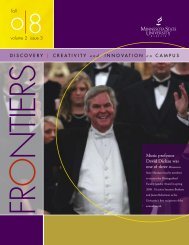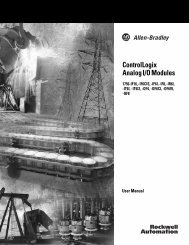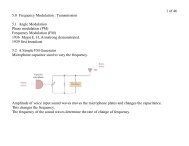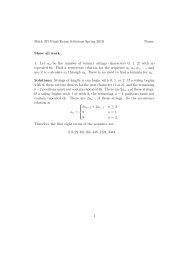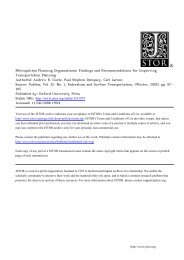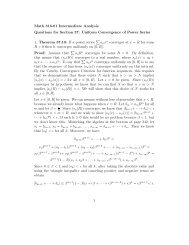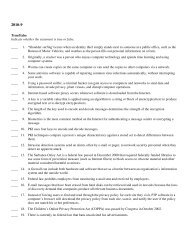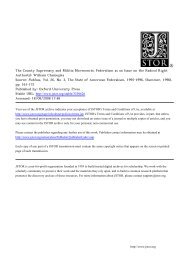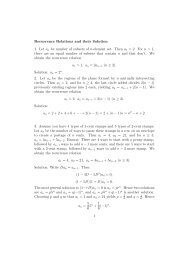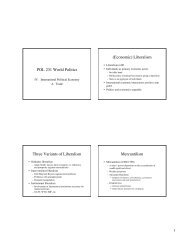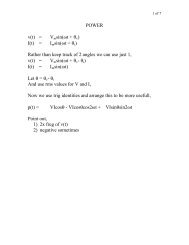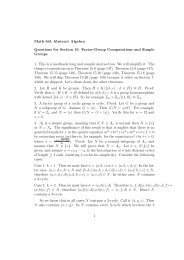Clemons and McBeth - MavDISK
Clemons and McBeth - MavDISK
Clemons and McBeth - MavDISK
You also want an ePaper? Increase the reach of your titles
YUMPU automatically turns print PDFs into web optimized ePapers that Google loves.
48<br />
Portersville citizens overwhelmingly wanted a primary (basic).healthcare clinic but<br />
only otlethat their smalI community could support without any large increases in taxes.<br />
From the survey <strong>and</strong> focus groups, it was detel'mined that the major evaluation criterion<br />
was .simply cost <strong>and</strong> effectiveness (would the clinic meet the needs of the citizens?).<br />
From this information, the community leaders brainstormed several alternative struc-<br />
tures. Using local building contractors, cost estimates were conducted <strong>and</strong> the pros <strong>and</strong><br />
cons of each design discussed. A medical planning expert was brought in <strong>and</strong> took the<br />
community through a "health care utilization" planning process. This process used the<br />
cOffiII).unity'sage profile from census data to show dem<strong>and</strong> for basic medical services.<br />
This formula predicts the annual number of primary care patients based on a commu-<br />
nity's demograpl1ic profile of age <strong>and</strong> gender. The formula was based on an empirical<br />
analysis of primary health utilization by age groups. For Portersville, the predicted number<br />
of primary care patients per year was 1,339. Using this number, the health care planner<br />
then was able to use another formula to subdivide the categories of likely utilization.<br />
For example, a certain percentage of the primary care visits would be vaccinations, a certain<br />
percentage for flu, <strong>and</strong> a certain percentage for broken bones, <strong>and</strong> so on. The data calculated,<br />
were then multiplied by the fees charged for each type of medical procedure,<br />
producing an estimated annual revenue flow for the proposed clinic. .<br />
With this revenue data in h<strong>and</strong>, <strong>and</strong> knowing what the county could afford tOisubsidize<br />
in the form of taxes, the planner decided that a much less-expensive <strong>and</strong> elaborate<br />
StrUcture should be built. It was clear that the proposed 4,lOO-square-foot, $750,000 strUc-<br />
ture was weIl beyond the needs <strong>and</strong> resources of Portersville. This rationai<strong>and</strong> empirical<br />
analysis helped the community underst<strong>and</strong> both what PortersvilIe would support financially<br />
<strong>and</strong> the correlated likely dem<strong>and</strong> for services.<br />
The leadership group then engaged in some brainstorming <strong>and</strong> quickly determined<br />
that a simple 2,500-square-foot customized house could easily serve the community's<br />
health care needs. So, the two options now on the table were as follows:<br />
Option #1: A 4,100-square-foot building at a cost of $750,000<br />
Option #2: A customized house converted into a health clinic at around $100,000 in costs<br />
Health care experts <strong>and</strong> community physicians all agreed that the customized house<br />
wouldmakean effectivehealth clinic. The costs were easily absorbedby the.community<br />
<strong>and</strong>by the county'sexisting tax base.<br />
This case is a good example of the usefulness of the rational model. The $750,000 build-<br />
ing fi~t proposed by the architect could easily have destroyed the community's chances of getting<br />
a health care clinic. In retrospect, it is easy to see that the $750,000 building was not going<br />
:0 work in such a small community. But community leaders were excited about the elaborate<br />
iesign <strong>and</strong> the prospect of having such a facility in their town. Without rational analysis, the<br />
lttempt to sell this StrUctureto the community would have failed miserably, <strong>and</strong> if the building<br />
lad been built it would have been underutilized-a white elephant sitting mostly unused. The<br />
:urveys, focus groups, <strong>and</strong> outside experts helped the community leaders focus on the problem<br />
Ind on a politically acceptable solution. Evaluation criteria were discovered, solutions generled,<br />
pros <strong>and</strong> cons discussed,-<strong>and</strong> eventually a successful decision was generated.<br />
PARTJ . THEORYAND PRACTICE CHAPTER2 . THE RATIONALPUBUC POUCy METHOD 49<br />
t<br />
I<br />
i<br />
SMALL<br />
CHANGE<br />
FIGURE 2-2 DECISIONALTYPES<br />
PROBLEM DEFINITION<br />
(Agreement)<br />
Health<br />
Clinic<br />
Case<br />
PROBLEM DEFINITION<br />
(No Agreement)<br />
2<br />
4<br />
LARGE<br />
CHANGE<br />
The decision made in the Portersville case resulted in a policy in which problem definition<br />
was agreed upon <strong>and</strong> the policy change was small (the community already had a small<br />
clinic). The decision rested in quadrant I of the 2 X 2 matrix represented in Figure 2-2<br />
(adapted from Braybrooke <strong>and</strong> Lindblom 1970, 78).<br />
Some scholars suggest that it is only on the rare <strong>and</strong> relatively less-important issues<br />
like the Portersville Health Clinic, <strong>and</strong> unlike Vietnam, where the rational model makes<br />
sense. (Deciding what to do in Vietnam, especially with all the value conflict over problem<br />
definition, places it squarely in quadrant 4.) For example, Braybrooke <strong>and</strong> Lindblom<br />
(1970, pp. 78-79), referring to a rational model of policymaking as synoptic methods,<br />
write that "Synoptic methods. . . are limited to . . . those happy if limited circumstances<br />
in which decisions effect sufficiently small change to make synoptic underst<strong>and</strong>ing possible."<br />
They also quote Herbert Simon stating: "Rational choice will be feasible to the extent<br />
that the limited set of factors upon which decision is based corresponds, in nature, to a<br />
closed system of variables" (p. 39).<br />
In sum, the charge has been levied that the rational model is of little relevance or value<br />
to the policy analyst. Is this true? How does one evaluate models? An explanation of model<br />
evaluation follows.<br />
Model Evaluation<br />
The rational model, like almost all models, can best be judged by three criteria. The first<br />
criterion is the ability to accurately describe. The fancy word scholars use for this is<br />
verisimilitude. Verisimilitude translates to the two familiar words it sounds like-very similar.<br />
In other words, models are usually expected to describe accurately. A model of a B-52<br />
bomber should look enough like the real thing that you can identify it or at least distinguish<br />
it from the model of the space shuttle (even assuming you know no more about airplanes<br />
than the authors of this text).<br />
The second criterion is what has been called the ah-hah factor. That is, models should<br />
explain the world to us; they should help us make sense of what it is they purport to represent.




